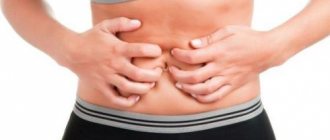One of the main syndromes of pathology of the upper gastrointestinal tract in children is gastric dyspepsia syndrome.
Dyspepsia ( digestive disorder ) is the presence of abdominal pain or discomfort in the upper abdomen, and there may be other symptoms (nausea, heartburn, belching, a feeling of fullness and fullness, bloating, etc.). Symptoms may or may not be related to food intake. The term "chronic dyspepsia" is used when symptoms persist for 3 months or more. There is a distinction between organic and inorganic dyspepsia .
Motor dyspepsia in children
One of the functional disorders of the stomach is motor dyspepsia , caused by changes in its peristalsis (hyper- or hypokinesia) and (or) muscle tone (hyper-or hypotension), accelerating or delaying the evacuation of gastric contents and manifested by pain, heartburn, belching, nausea and vomiting.
Motor dyspepsia may be based on a number of reasons, primarily nutritional reasons (poor diet, consumption of spicy, irritating and soggy foods), functional or organic changes in the central nervous system. Gastric hypertension is observed with gross food errors (cold cutlet hastily); hypotension, as a rule, after prolonged stasis in a child with dysmesenchymosis, with spasm or stenosis of the pylorus.
Prevention
Preventive measures include diet and following the timing of the introduction of complementary foods.
The child should regularly visit the pediatrician, undergo periodic examinations and, in case of any illness (especially if there are infections), undergo a full course of treatment.
After functional dyspepsia, newborn children most often recover within a few days; it does not provoke any exacerbations or complications of the child’s condition. However, if the body's protective function is too weakened, a transition from a functional form to a toxic one may occur. In this case, everything depends on the speed and quality of the first aid provided.
In general, if you arm yourself with patience, you can achieve good results over time when treating dyspepsia syndrome in children.
Flatulence, gas production and flatulence in a child, children
A significant amount of gas passes through the digestive tract of healthy people every day, and this is perceived as a natural process. The accumulation of a large amount of gases can be caused by aerophagia, the formation of a large amount of gases in the intestines due to dysbiosis, consumption of carbohydrates (cabbage, legumes), impaired absorption of gases in the intestines (for heart disease - consultation with a pediatric cardiologist, cirrhosis of the liver, etc.), incomplete or complete intestinal obstruction. The initial disorder that causes functional bloating and pain is a violation of intestinal motility, which leads to the patient feeling pain with a volume of intestinal gas that is easily tolerated by healthy people.
Increased gas formation in the intestines is observed after eating certain foods, such as cabbage, legumes, rye or bran bread, some cereals, in case of malabsorption of carbohydrates (lactose, sucrose), pathological bacterial colonization of the small intestine or infection with Lamblia intestinalis.
Analysis of stool for dysbacteriosis in children - Markushka clinic.
Flatulence (emission of gases) occurs with constipation, accompanied by putrefactive fermentation. Most often, gases are released during bowel movements. Conscious release of gases indicates that they are accumulating in large quantities in the colon.
Polyfecalia in children
In children, the amount of feces exceeds 2% of food eaten and liquid drunk. It should be taken into account that the amount of feces increases with age. The amount of excrement in children of the 1st year of life is relatively greater than in older children and adults.
Polyfecalia is characteristic primarily of malabsorption syndrome. Polyfecality and stool disorders in chronic pancreatitis are caused by a violation of the topography of cavity and membrane digestion due to enzymatic deficiency.
Hungry stools resemble dyspeptic stools, but are usually thicker, darker, and may contain an admixture of mucus.
With simple dyspepsia, the stool is liquid, contains an admixture of greens (due to the rapid transit of biliverdin impurities through the intestines) and white lumps (a large amount of calcium soaps), a sour odor, and often foamy (fermentative dyspepsia).
Causes
In infants, the main root cause of the disease will be a nutritional factor (nutritional dyspepsia), in other words, deficiencies in the child’s diet. Common food causes that cause dyspepsia in newborns may include:
- discrepancy between the volume and composition of food consumed and the capabilities of the digestive system;
- feeding a formula that is not of good quality;
- premature introduction of complementary foods;
- binge eating;
- unformed digestive tract;
- toxic poisoning (in toxic form);
- enzyme deficiency.
Pathology mainly affects children who are carriers of other diseases:
- disorders of the central nervous system,
- rickets,
- protein-energy malnutrition,
- allergic reaction,
- exudative-catarrhal diathesis,
- anemia,
- vitamin deficiency,
- helminthiasis,
- prematurity.
As a rule, dyspepsia manifests itself due to the fact that the enzymatic function of the infant’s digestive system is still imperfect and is unadapted and hypersensitive to any changes in the diet.
Constipation in a child, children
Constipation is a long-term (more than 48 hours) delay in bowel movement, accompanied by difficulty in defecation, as well as a small amount (less than 100 g per day) or increased hardness of feces, and a feeling of incomplete bowel movement. Constipation can be organic and functional. The most common causes of constipation are:
1) nutritional defects, malnutrition, monotonous milk nutrition, lack of products in the diet of older children that provide a significant amount of food waste; 2) anatomical defects in the development of the intestine, malformations of the anorectal zone; 3) atonic intestinal conditions; 4) reflex constipation with cracks and abrasions of the anus and rectum.
If children do not have stool for several days from birth, one should think about congenital anomalies of intestinal development. In older children, constipation is observed with hypothyroidism, colitis, dolichocolon, megacolon. Mechanical obstacles and medications (atropine-like, catecholamines) lead to constipation.
Among functional constipation, spastic or hypokinetic constipation is most common. As a result of the absorption of rotting products from the intestines during chronic constipation, children’s well-being is disrupted: increased fatigue, headaches appear, appetite decreases, and sleep deteriorates.
Conditioned reflex constipation appears in a child as a result of a change in the usual lifestyle: with the start of attending kindergarten, school, when the usual time of defecation shifts.
In the occurrence of psychogenic constipation, factors such as prolonged and frequent stressful situations in the family, school, excessive emotional and mental stress with simultaneous physical inactivity are important.
Treatment and first aid
If dangerous signs are detected, the main goal is to transport the child to a medical facility to provide qualified medical care.
If vomiting is not associated with dangerous pathologies, parents can alleviate the child’s condition using the following measures:
- Drink plenty of fluids. The liquid should be slightly cool. If vomiting is mild and infrequent, you can give your child green tea without sugar.
- Provide physical and emotional peace.
- When lying down, turn the child's head to the side to prevent vomit from entering the respiratory tract.
- Use of rehydration agents for prolonged and profuse vomiting. If vomiting continues and oral administration is not possible, seek medical attention for intravenous fluids and electrolytes.
Depending on the identified cause of vomiting, the doctor may prescribe the following medications:
- Antibiotics and antiviral drugs.
- Anti-inflammatory drugs.
- Antiemetic drugs.
- Antispasmodics and antipyretics.
- Antihistamines.
Parents are not recommended to use medications on their own, since their action can change the clinical picture of the pathology.
This video will tell you how to help your child if he is vomiting:
https://www.youtube.com/watch?v=RFnlu5BFkjE
Fecal incontinence in a child, children
Fecal incontinence (encopresis) is a functional disorder of defecation in which there is a dysfunction of the rectum and external or internal sphincters of the anus, manifested by involuntary defecation.
Clinically, fecal incontinence, regardless of the cause, manifests itself in the same way: a dry and clean child begins to involuntarily lose more or less amount of feces. These phenomena can occur acutely, develop quickly and end in recovery within a short time, or develop slowly and progress steadily.
Diarrhea in children, child
Diarrhea (diarrhea) is frequent bowel movements with the release of thin and, in some cases, copious feces. The reason in any case is the disruption of the processes of digestion, absorption and transport of essential nutrients in the intestines. It is customary to distinguish four types of diarrhea: osmotic, secretory, motor and exudative.
The osmotic type of diarrhea is characterized by an increase in osmotic pressure in the intestinal cavity. It is observed when the digestion and absorption of carbohydrates is impaired.
Exudative diarrhea is characteristic of inflammatory diseases of the colon, diverticulosis, invasive infections (dysentery, salmonellosis, etc.), exudative enteropathy (intestinal lymphangiectasia).
The motor component of diarrhea is present in almost all cases of malabsorption syndrome and is caused by increased intestinal peristalsis due to distension of the intestine and osmo- and baroreceptors by a large volume of contents and the synthesis of hormonally active substances that enhance motility.
Secretory diarrhea occurs under the influence of bacterial toxins.
Changes in stool in some diseases in children
Liquid, foul-smelling stool , up to 10 times a day, in the form of pea puree, is observed with typhoid fever, sometimes containing a small amount of mucus. Stool analysis in children - medical.
With dysentery, the stool is light, mixed with mucus, streaks of blood, pus, odorless, like “rectal spitting” against the background of tenesmus. Sometimes there are no fecal masses at all.
Salmonellosis is characterized by an acute onset of the disease with high fever, vomiting, and abdominal pain. The stool is copious, watery, foul-smelling, with an admixture of greenery, like “swamp mud.” There is a small amount of mucus and, as a rule, there is no blood.
With cholera, the disease begins with moderate pain around the navel and frequent loose stools against a background of normal or low-grade fever. Dehydration develops quickly, accompanied in severe cases by vomiting and fever. The stool is copious, watery, odorless, like “rice water” (whitish liquid with flakes of mucus), and never contains blood.
In diseases caused by enterotoxigenic Escherichia coli , young children experience copious, watery, colorless bowel movements with mucus flakes.
With escherichiosis caused by enteroinvasive E. coli, there is a high temperature with scanty bowel movements mixed with mucus, blood, and abdominal pain.
Diseases caused by enteropathogenic Escherichia coli are observed in children under the age of 1.5-2 years and are characterized by a gradual onset with moderate watery bowel movements, low-grade fever and an undulating course.
With adenoviral and enteroviral diarrhea , other clinical signs of these diseases are observed, the stool is fecal in nature, 3-5 times a day, and dehydration does not develop.
With rotavirus gastroenteritis (for 30-40% of all patients), an acute onset of the disease is observed with fever, vomiting (gastroenteritis variant) and (or) copious watery stools (enterocolitic variant), sometimes with an admixture of mucus, against a background of scanty respiratory symptoms (moderate hyperemia , granularity of the soft palate and arches, nasal congestion) with rumbling along the large intestine. The disease has a strict seasonality (October-March). Young children get sick.
Staphylococcal enterocolitis is more common in children under one year of age, in the presence of a characteristic epidemic history (purulent foci in the child, unfavorable premorbid background, mastitis in the mother, long-term treatment with antibiotics, etc.). There is a gradual development of intestinal dysfunction against the background of low-grade fever and moderate intoxication. The stool is liquid, fecal, mixed with mucus and sometimes streaked with blood.
For staphylococcal food toxicoinfection, a typical indication is the consumption of infected food (cakes, creams, pastries, salads with mayonnaise); The disease most often has a group nature. Characterized by rapid development of the disease with persistent, debilitating vomiting against a background of high fever and rapid normalization of the condition within 2-3 days. The stool is liquid, watery, sometimes fecal, without pathological impurities.
Campylobacteriosis is characterized by an acute onset of the disease with pain in the abdominal area, mainly around the navel, previous intestinal dysfunction, enlarged liver and involvement of the pancreas in the process, copious, “foamy”, foul-smelling stools mixed with blood.
Yersiniosis is characterized by the presence of multiple organ symptoms (skin rash, joint pain, enlarged liver and spleen) . In the intestinal form, pain is observed in the abdominal area, mainly in the right iliac region. Stool 3-6 times a day, liquid, fetid, fecal, mixed with mucus.
With amoebiasis, stools are frequent, in the form of “raspberry jelly” (mucus gives the stool a glassy, shiny surface). With giardiasis, stool 3-4 times a day, yellow-green in color, soft consistency. With massive infestation, stools become more frequent up to 20 times a day and become mucous and bloody.
With mycotic enterocolonopathies (candidiasis), there is an increase in bowel movements, abundant, liquid or pasty feces, usually without a large admixture of mucus (blood, as a rule, is absent).
With viral hepatitis, the stool is acholic - gray-clay color, without pathological impurities. Vaccination of a child against hepatitis at the Markushka children's clinic.
Bleeding from the gastrointestinal tract in children
Bleeding from the gastrointestinal tract in young and older children is common and can be life-threatening. The nature of the stool can determine the source of bleeding. If it is located in the upper parts of the gastrointestinal tract (esophagus, stomach, duodenum and small intestines), then the patient experiences melena (black homogeneous stool due to changes in blood hemoglobin under the influence of gastric juice, enzymes and intestinal flora). This is most often bleeding due to varicose veins of the esophagus, peptic ulcer (duodenal and stomach, acute ulcers of drug origin), hemorrhagic gastritis.
In cases of bleeding from the terminal ileum and colon, the color of the blood in the feces is little changed. The discharge of fresh blood from the anus more often indicates the localization of the source of bleeding in the colon: colon or rectal polyp, fissure of the rectal mucosa, hemorrhoids, Meckel's diverticulum ulcer, ulcerative colitis, Crohn's disease, intestinal hemangioma. Bleeding from the rectum accounts for about 50% of all gastrointestinal bleeding. With anal fissures, the blood is scarlet in color and is usually detected separately from the stool.
Diagnostics
As a rule, the diagnosis of dyspepsia in children includes the following points.
- Analysis of the medical history, complaints and life of the patient.
- Laboratory diagnostics:
- clinical and biochemical blood tests;
- stool tests for occult blood;
- coprogram for putrefactive dyspepsia in an infant - stool analysis.
- Instrumental methods of analysis:
- stomach acid test;
- esophagogastroduodenoscopy (gastroscopy);
- impedance-pH-metry of the esophagus;
- examination of fragments of the gastric mucosa and a breath test for the presence of Helicobacter pylori infection;
- computed tomography (CT);
- Ultrasound of the abdominal organs;
- intestinal colonoscopy;
- electrogastrography;
- radiography;
- esophagomanometry and antroduodenal manometry.
In addition to various studies and tests, it would also be a good idea to consult with a gastroenterologist.









